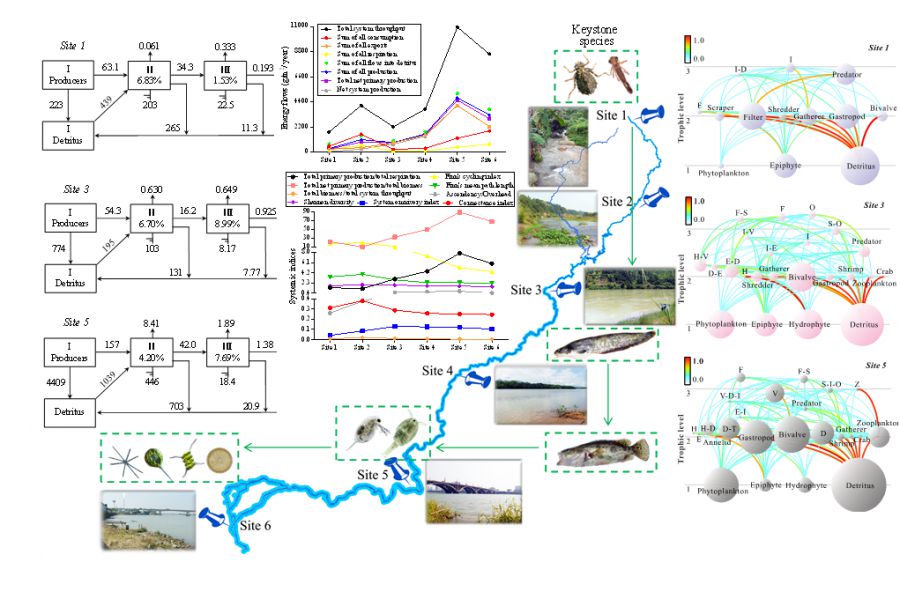| 論文篇名 | 英文:Longitudinal variation in energy flow networks along a large subtropical river in China 中文:亞熱帶溪流食物網能量流傳輸網絡在流域尺度的變異 |
| 期刊名稱 | Ecological Modelling |
| 發表年份,卷數,起迄頁數 | 2018, 387, 83-95 |
| 作者 | Wang S, Wang L, Li F, Chang HY, Tang JP, Zhou XA, Long SX, Li X, Lin HJ*(林幸助), Yang Y* |
| DOI | 10.1016/j.ecolmodel.2018.08.019 |
| 中文摘要 | 為了解亞熱帶溪流生態系結構與功能在流域尺度的變異,在東江從上游到下游建構6個食物網Ecopath模式。輸入參數主要來自於2012-2016年的野外實測資料,並利用網絡分析(Network analysis)分析能量傳輸情形。模式輸出結果顯示空間異質性高生物量、生產量及攝食量主要集中於營養階層(TL) II,貢獻約76%。在上游主要貢獻者是水棲昆蟲,中游是軟體動物,下游是浮游動物。肉食性魚類位居最高營養位階,達2.95-3.50。基石物種(Keystone group)從上游的odonate larvae,中上游的食魚性魚類,到下游的浮游動物,轉換到河口的浮游植物。水棲昆蟲、食水蟲魚類、附生藻類及水生植物的生態營養效率> 0.99,顯示他們是食物網能量傳輸中的關鍵物種。營養階層II-IV的平均傳輸效率(mean transfer efficiencies,TEs)在上游最低(1.8-4.1%),中游最高(8.0-8.4%),但是下游又下降到6.4-7.0%。上游營養階層傳輸效率低的原因是因為缺乏肉食性魚類,下游則是因為食軟體動物及浮游生物的動物過少。生態系參數分析顯示上游原始的溪流生態系相對成熟,相反地,下游生態系組織因為浮游藻類生產過多,能量再循環迴路短,因此仍處於發展中階段。 |
| 英文摘要 | To understand the longitudinal variation in the structure and functioning of large river ecosystems, six Ecopath models were constructed to exhibit the energy flows of aquatic food webs along the subtropical East River in China. Input parameters were primarily obtained from field data collected in 2012–2016; model outputs were estimated by network analysis. Longitudinally, ecosystem characteristics of the East River had high spatial heterogeneity. The biomass, production, and consumption, of which>75.8% of each was distributed at trophic level (TL) II, were determined by aquatic insects upstream, molluscs midstream, and zooplankton downstream. Carnivorous fish occupied the maximal TL of 2.95–3.50. Due to the different trophic interactions of regional food webs, the keystone groups shifted from odonate larvae in headwaters to piscivorous fish upstream/midstream, to zooplankton downstream, and to phytoplankton near the estuary. Aquatic insects, insectivorous fish, epiphytes, and hydrophytes, all of which had ecotrophic efficiencies>0.99, were critical groups that influenced mass balance through short prey supply. The mean transfer efficiencies (TEs) through TLs IIeIV had the lowest values of 1.8–4.1% upstream and increased to the highest levels of 8.0–8.4% midstream before they decreased to 6.4–7.0% downstream. The low TEs along the river were limited mainly by the lack of carnivorous fish upstream and the low predation on mollus and plankton midstream/downstream. A series of theory and information indices showed that the pristine upstream system was mature but underdeveloped in organisation; in contrast, the downstream systems in the urban and industrial reaches were immature and stressed in terms of excessive phytoplankton production and short cycling. |
Longitudinal variation in energy flow networks along a large subtropical river in China 2018-09-15

生態農業:農業溫室氣體減量【生命科學系林幸助教授】






